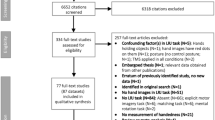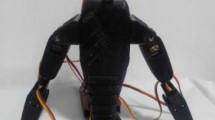Abstract
The present study attempted to demonstrate that the indicator arm influences end point distribution in contralateral multi-joint proprioceptive tasks and also that intrinsic physical characteristics of multi-joint arms (arm stiffness) may predict the error pattern. For this purpose, we carried out two types of contralateral localization tasks with multi-jointed arm movements. In the concurrent localization task, the end point distribution was significantly more elongated in the direction of the lower stiffness at each target position when based on the indicator stiffness, while in the remembered localization task, there was no significant difference between the axes. The best-fit ellipse for the end point distribution also confirmed those results. These findings may support the idea that a large part of the configuration of end point distribution could be determined by the characteristics of arm stiffness of the indicator arm in the condition without memory decay of position representation. Further, error bias of proprioceptive localization may be influenced by the combined effect between movement direction and orientation of the lower stiffness. In conclusion, this study suggests that error patterns largely reflect indicator factors such as the elastic property of the arm in multi-joint proprioceptive tasks, which have been assumed to assess the proprioceptive sense of the reference arm.






Similar content being viewed by others
References
Adamo DE, Martin BJ (2009) Position sense asymmetry. Exp Brain Res 192:87–95
Adamo DE, Martin BJ, Brown SH (2007) Age-related differences in upper limb proprioception. Percept Mot Skills 104:1297–1309
Aimonetti JM, Hospod V, Roll JP, Ribot-Ciscar E (2007) Cutaneous afferents provide a neuronal population vector that encodes the orientation of human ankle movements. J Physiol 580:649–658
Allen T, Ansems GE, Proske U (2007) Effects of muscle conditioning on position sense at the human forearm during loading or fatigue of elbow flexors and the role of the sense of effort. J Physiol 580:423–434
Ansems GE, Allen TJ, Proske U (2006) Position sense at the human forearm in the horizontal plane during loading and vibration of elbow muscles. J Physiol 576:445–455
Burke D, Hagbarth KE, Lofstedt L, Wallin BG (1976) The responses of human muscle spindle endings to vibration of non-contracting muscles. J Physiol 261:695–711
Collins DF, Prochazka A (1996) Movement illusions evoked by ensemble cutaneous input from the dorsum of the human hand. J Physiol 196:857–871
Collins DF, Refshauge KM, Todd G, Gandevia SC (2005) Cutaneous receptors contribute to kinesthesia at the index finger, elbow, and knee. J Neurophysiol 92:1699–1706
Crowe A, Keessen W, Kuus W, van Vliet R, Zegeling A (1987) Proprioceptive accuracy in two dimensions. Percept Mot Skills 64:831–846
Darainy M, Malfait N, Gribble PL, Towhidkhah F, Ostry D (2004) Learning to control arm stiffness under static conditions. J Neurophysiol 92:3344–3350
Dukelow SP, Herter TM, Moore KD et al (2010) Quantitative assessment of limb position sense following stroke. Neurorehabil Neural Repair 24:178–187
Edin BB, Johansson N (1995) Skin strain patterns provide kinaesthetic information to the human central nervous system. J Physiol 487:243–251
Franklin DW, Liaw G, Milner TE, Osu R, Burdet E, Kawato M (2007) Endpoint stiffness of the arm is directionally tuned to instability in the environment. J Neurosci 27:7705–7716
Fuentes CT, Bastian AJ (2010) Where is your arm? Variations in proprioception across space and tasks. J Neurophysiol 103:164–171
Gandevia SC, Smith JL, Matthew C, Proske U, Taylor JL (2006) Motor commands contribute to human position sense. J Physiol 571:3703–3710
Goble DJ, Brown SH (2010) Upper limb asymmetries in the perception of proprioceptively determined dynamic position sense. J Exp Psychol Hum Percept Perform 36:768–775
Goble DJ, Noble BC, Brown SH (2010) Where was my arm again? Memory-based matching of proprioceptive targets is enhances by increased target presentation time. Neurosci Lett 481:54–58
Gomi H, Osu R (1998) Task dependent viscoelasticity of human multijoint arm and its spatial characteristic for interaction with environment. J Neurosci 18:8965–8978
Goodwin GM, McCloskey DI, Matthews PB (1972) Proprioceptive illusions induced by muscle vibration: contribution by muscle spindles to perception? Science 24:1382–1384
Gordon J, Ghilardi MF, Ghez C (1994) Accuracy of planar reaching movements. I. Independence of direction and extent variability. Exp Brain Res 99:97–111
Gribble PL, Mullin LI, Cothros N, Mattar A (2003) Role of cocontraction in arm movement accuracy. J Neurophysiol 89:2396–2405
Gritsenko V, Krouchev NI, Kalaska JF (2007) Afferent input, efference copy, signal noise, and biases in perceptions of joint angle during active versus passive elbow movements. J Neurophysiol 98:1140–1154
Itaguchi Y, Fukuzawa K (2012) Effects of arm stiffness and muscle effort on position reproduction error in the horizontal plane. Percep Mot Skills 114:757–773
Jones AAH, Cressman EK, Henriques DYP (2010) Proprioceptive localization of the left and right hands. Exp Brain Res 204:373–383
Kelso JA (1977) Planning and efferent components in the coding of movement. J Mot Behav 9:33–47
Lametti DR, Ostry DJ (2010) Postural constraint on movement variability. J Neurophysiol 104:1061–1067
Lametti DR, Houle G, Ostry DJ (2007) Control of movement variability and the regulation of limb impedance. J Neurophysiol 98:3516–3524
Laufer Y, Hocherman S, Dickstein R (2001) Accuracy of reproducing hand position when using active compared with passive movement. Physiother Res Int 6:65–75
McIntyre J, Mussa-Ivaldi FA, Bizzi E (1996) The control of stable postures in the multi-joint arm. Exp Brain Res 110:248–264
Mussa-Ivaldi FA, Hogan N, Bizzi E (1985) Neural, mechanical and geometric factors subserving arm posture in human. J Neurosci 5:2732–2743
Paillard J, Brouchon MA (1974) Proprioceptive contribution to the spatial encoding of position cues for ballistic movements. Brain Res 71:273–284
Ribot-Ciscar E, Roll JP (1998) Ago-Antagonist muscle spindle inputs contribute together to joint movement coding in man. Brain Res 791:167–176
Roll JP, Vedel JP (1982) Kinaesthetic role of muscle afferents in man, studied by tendon vibration and microneurography. Exp Brain Res 47:177–190
Sarlegna FR, Sainburg RL (2007) The effect of target modality on visual and proprioceptive contributions to the control of movement distance. Exp Brain Res 176:267–280
Smith JL, Crawford M, Proske U, Taylor JL, Gandevia SC (2009) Signals of motor command bias joint position sense in the presence of feedback from proprioceptors. J Appl Physiol 106:950–958
Soechting JF, Flanders M (1989) Sensorimotor representation for pointing to targets in three-dimensional space. J Neurophysiol 62:582–594
Stelmach GE, Kelso JA, Wallace SA (1975) Preselection in short-term motor memory. J Exp Psychol Hum Learn Mem 1:745–755
van Beers RJ, Sittig AC, Denier JJ, van der Gon D (1998) The precision of proprioceptive position sense. Exp Brain Res 122:367–377
Vindras P, Viviani P (1998) Frames of reference and control parameters in visuomanual pointing. J Exp Psychol Hum Percept Perform 24:569–591
Walsh LD, Allen TJ, Gandevia SC, Proske U (2006) Effect of eccentric exercise on position sense at the human forearm in different postures. J App Physiol 100:1109–1116
Wilson ET, Wong J, Gribble PL (2010) Mapping proprioception across a 2D horizontal workspace. PLoS One 5:e11851
Winter JA, Allen TJ, Proske U (2005) Muscle spindle signals combine with the sense of effort to indicate limb position. J Physiol 568:1035–1046
Author information
Authors and Affiliations
Corresponding author
Rights and permissions
About this article
Cite this article
Itaguchi, Y., Fukuzawa, K. The influence of the indicator arm on end point distribution in proprioceptive localization with multi-joint arms. Exp Brain Res 222, 77–88 (2012). https://doi.org/10.1007/s00221-012-3196-3
Received:
Accepted:
Published:
Issue Date:
DOI: https://doi.org/10.1007/s00221-012-3196-3




